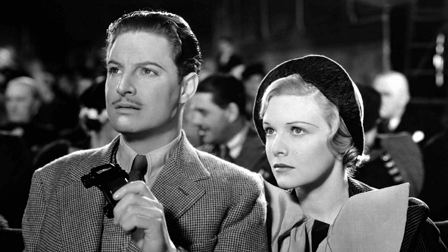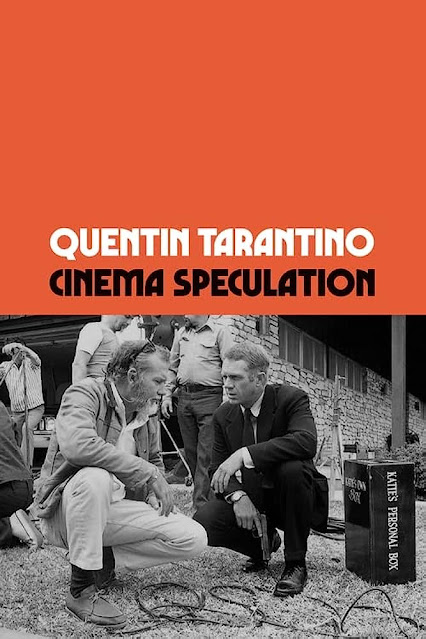The 39 Steps (1935)
 |
| Pamela (Madeleine Carroll) and Hannay (Robert Donat) |
The film is based on John Buchan's 1915 novel The Thirty-Nine Steps, but the translation to film is so loose I think “inspired by” would probably be the more accurate description. In fact, the film strays so far from the novel that the writers had to create a new explanation for the title, having forgotten to include the actual steps that feature in the book.
The hero of Buchan's novel is Richard Hannay. On a visit to London from South Africa, he finds himself mixed up in a spy plot when one of his neighbours, a freelance American agent called Scudder, is murdered by enemy spies. He had stumbled onto a sinister plot and has crucial information contained in code in his notebook. Framed for murder, Hannay heads to Scotland to evade the police and to give him time to decode the information in the book.
 |
| Original posters emphasised the romantic element |
Her murder sets into motion a breathless chase as Hannay heads in a north by northwesterly direction (alright then, north) to Scotland. When the police catch up with him on the train, he throws himself onto a young woman (Madeleine Carroll) hoping they will be mistaken for a couple. When she betrays him, he escapes from the moving train and onto the Forth Bridge. This is one of the film's most famous scenes and represents another popular, but still developing, Hitchcock trope, the action sequence on a famous landmark.
Robert Donat makes Hannay an appealing hero, vulnerable and yet insouciant in the face of danger, and he makes you feel every moment of Hannay's desperation and uncertainty as he is pursued on the train and across the Scottish countryside. Donat was already known to American audiences after appearing in The Private Life of Henry VIII (1933) and starring in The Count of Monte Cristo (1934), and his casting was a shrewd move, helping the film become Hitchcock's first to get a wide release in the US. The 39 Steps also made Donat a highly sought after star, but he preferred England to Hollywood, and his career was continually hampered by ill-health.
 |
| Hannay must be travelling 3rd Class in this scene |
The screenplay introduces several female characters absent from the book. The most significant is Pamela (Madeleine Carroll), the woman who betrays Hannay on the train and again at a political meeting. She and Hannay are handcuffed together after he is “arrested” by two spies pretending to be policemen. Pamela is beautiful, cool, intelligent and initially completely hostile to Hannay. She is also the first true Hitchcock blonde, and one of the best, and Carroll's sparring with Donat is one of the film's highlights. Madeleine Carroll went on to star in Hitchcock's Secret Agent the following year and was snapped up by Hollywood, where she was briefly the world's highest paid actress.
The film is a little risqué for its time, most famously in the scenes where Hannay and Pamela have to share a bed while handcuffed together, as well as a humorous scene on the train with two ladies underwear salesmen. One scene carried over from the book has Hannay switching clothes with a milkman in order to leave his apartment undetected by enemy agents. In the novel, this is suggested to the milkman as being part of a bet. In the film, when the milkman doesn't believe Hannay's story about spies, Hannay tells him instead that he's having an illicit affair with a married woman, and the two men outside are her husband and brother.
The film also presents the audience with a series of male-female couples throughout its running time. Firstly Hannay and Annabella Smith, then the crofter and his wife, then the innkeeper and his wife, and finally Hannay and Pamela. Perhaps there is some significance in the fact that Hannay and Pamela are handcuffed together and can't be separated. Its almost as if this is some sly comment on matrimony. When they are handcuffed, Pamela doesn't believe a word of Hannay's story about spies and secret plans. It's only when she is able to escape the handcuffs that she learns the truth for herself. She then returns to him willingly. The famous final shot, of the unmanacled couple now holding hands, with the handcuff still dangling from Hannay's wrist, seems to imply that relationships work better when they are sustained voluntarily, rather than by some outside force.
 |
| Hannay gives Pamela a helping hand |
The 39 Steps was mostly shot in the studio and this adds to its charm and gives the film a heightened sense of reality. By this time, the 35 year old Hitchcock was already British cinema's wunderkind, having directed The Lodger (1926), Blackmail (1929) (usually considered to be Britain’s first talkie) and The Man Who Knew Too Much (1934). The 39 Steps shows him on top form, and cemented his reputation as a master of technique and suspense. It was a hit on both sides of the Atlantic, and caught the attention of David O. Selznick, who would soon lure him to Hollywood. If you're looking for Hitchcock's cameo appearance, he's the man who drops some litter as he passes by in front of the bus, as Donat and Mannheim are leaving the music hall. The second passer-by is the film's screenwriter, Charles Bennett.
 |
| The finale at The Palladium |
The film is also one of Hitchcock's most imitated. Hitchcock himself re-used the same basic formula in Young and Innocent (1937), Saboteur (1942) and North by Northwest (1959). It also led to two remakes, in 1959 and 1978, and a third one for TV in 2008, and has inspired many other “innocent man” films. In the ultimate accolade, the Forth Bridge sequence was spoofed by the Carry On team in Carry on Regardless in 1961.
The 39 Steps is one of Hitchcock's most breathless and most entertaining films, and packs an enormous amount into its 87 minutes of screen time. The MacGuffin isn't really of great importance – in case you forgot (and you did, didn't you?) the whole thing was about the plans for a secret new aeroplane. But it's really the journey that's important here, much more than the final destination.
The 39 Steps
Year: 1935
Genre: Spy Thriller
Country: UK
Director: Alfred Hitchcock
Cast Robert Donat (Richard Hannay), Madeleine Carroll (Pamela), Lucie Mannheim (Annabella Smith), Godfrey Tearle (Professor Jordan), Peggy Ashcroft (Margaret, the crofter's wife), John Laurie (John, the crofter), Helen Haye (Mrs Jordan), Frank Cellier (Sheriff Watson), Wylie Watson (Mr Memory), Jerry Verno and Gus Macnaughton (commercial travellers), Peggy Simpson (maid)
uncredited: Frederick Piper (milkman), John Turnbull (police inspector), Ivor Barnard (chairman of political meeting), Matthew Boulton (fake police officer), S.J. Warmington (detective), Vida Hope (usherette), Miles Malleson (Palladium manager), Hilda Trevelyan (innkeeper's wife)
Screenplay Charles Bennett (adaptation), Ian Hay (dialogue), Alma Reville (continuity), based on the novel by John Buchan Producer Michael Balcon (uncredited) Cinematography Bernard Knowles Art director O. Werndorff Editor D.N. Twist Music (uncredited) Hubert Bath, Jack Beaver, Charles Williams Music director Louis Levy
Genre: Spy Thriller
Country: UK
Director: Alfred Hitchcock
Cast Robert Donat (Richard Hannay), Madeleine Carroll (Pamela), Lucie Mannheim (Annabella Smith), Godfrey Tearle (Professor Jordan), Peggy Ashcroft (Margaret, the crofter's wife), John Laurie (John, the crofter), Helen Haye (Mrs Jordan), Frank Cellier (Sheriff Watson), Wylie Watson (Mr Memory), Jerry Verno and Gus Macnaughton (commercial travellers), Peggy Simpson (maid)
uncredited: Frederick Piper (milkman), John Turnbull (police inspector), Ivor Barnard (chairman of political meeting), Matthew Boulton (fake police officer), S.J. Warmington (detective), Vida Hope (usherette), Miles Malleson (Palladium manager), Hilda Trevelyan (innkeeper's wife)
Screenplay Charles Bennett (adaptation), Ian Hay (dialogue), Alma Reville (continuity), based on the novel by John Buchan Producer Michael Balcon (uncredited) Cinematography Bernard Knowles Art director O. Werndorff Editor D.N. Twist Music (uncredited) Hubert Bath, Jack Beaver, Charles Williams Music director Louis Levy
Running time 87 mins (black and white)
Production company Gaumont British Picture Corporation Distributor Gaumont British
See also:


Thanks so much for taking part. This is such a great film. Donat is perfect as the suave man caught up in something out of his control. I'm surprised he never again worked with Hitch. Saboteur is the film that most reminds me of this one. Maddy
ReplyDeleteI read that Hitch wanted Donat for Sabotage but there were contractual issues. I can easily imagine him in the Redgrave part in The Lady Vanishes.
DeleteI've watched this film so many times over my life that I'm in danger of taking it for granted. Your article pulled me up short and helped stop that.
ReplyDeleteHi Caftan Woman
DeleteHave you seen any of the remakes? I'm fond of both the 1959 and 1978 versions. The '59 one is almost a total failure as a thriller, but it still has a lot of charm as a star vehicle for Kenneth More.
Jay
Wonderful review! I had, indeed, forgotten the MacGuffin! I agree with you that this is the first film with all the "Hitchcock touches". And, contrary to Charles Bennett, I don't think the original story in the book was so bad!
ReplyDeleteDon't forget to read my contribution to the blogathon! :)
Cheers!
Le
http://www.criticaretro.blogspot.com
Thanks Le. I agree with you that Bennett was too harsh on the book, it's quite decent really, although the film improves on it in some ways, especially the addition of Pamela and the other female characters.
DeleteJay
What an excellent review! It really made me want to watch the film again. You really manage to capture all the essence of the film.
ReplyDeleteThanks, Virginie, for your kind words, it's much appreciated.
DeleteJay
Again, thanks for taking part in the blogathon! Of Hitchcock's early films, The 39 Steps and The Lady Vanishes are my favourites. I do think you summarised the film quite well. It really was in many ways the first true Hitchcock film. All of the elements are there, and Madeleine Carroll is not only the first Hitchcock blonde, but for me one of the best!
ReplyDeleteI can't choose between this one and The Lady Vanishes, they are both so good. But I like Young and Innocent a lot too, it's pretty underrated. And Madeleine Carroll is great, she's definitely one of my favourites too.
DeleteJay
Agreed – this has all the best elements of a Hitchcock film, and they're put together beautifully. This film never gets old, does it?
ReplyDeleteNo it doesn't, and I think a lot of it has to do with Donat, he's such an appealing hero.
DeleteJay